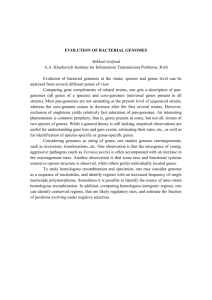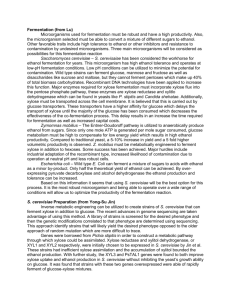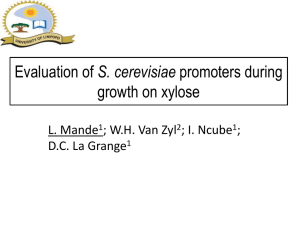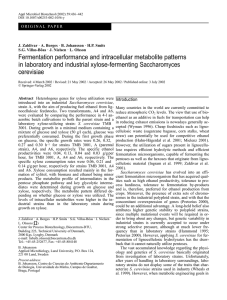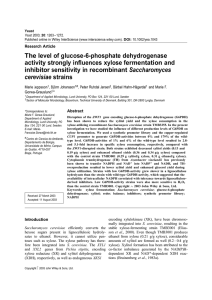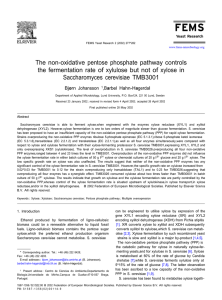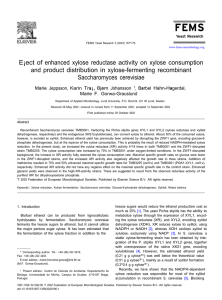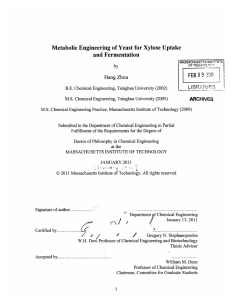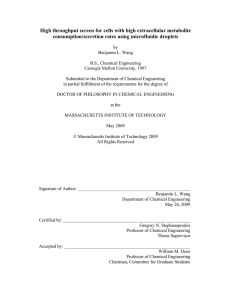Taklimat Penulisan FYP
advertisement
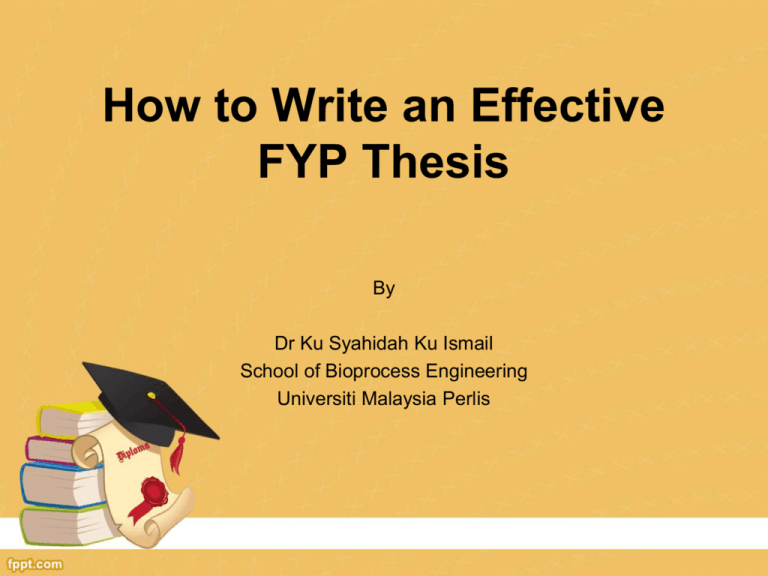
How to Write an Effective FYP Thesis By Dr Ku Syahidah Ku Ismail School of Bioprocess Engineering Universiti Malaysia Perlis Presentation Outline • • • • • Importance of an FYP thesis Thesis Body Common mistakes Useful set phrases Q&A FYP’s Purpose • Close the gap between research and teaching • Answer interesting research questions • Test your ability to do research • Test your ability to disseminate your findings Thesis writing • You are writing a story (Beginning Middle End) • Tell them what you are going to tell them • Must be easy to read and easy to understand • Minimize confusion – maximize understanding • English check Body of the Thesis • • • • • • • Abstract Introduction Literature Review Materials and Methods Results and Discussion Conclusion, Recommendation References Have you ever experienced this? The ‘write’ order For maximum clarity and consistency, write your manuscript in this order: • Methods • Results • Introduction • Discussion • Abstract • Title Write during the research process Write after obtaining/analyzing your results Write last Writing the Introduction Why is this study interesting? What has been studied previously? What is your research question? How are you going to answer it? The proportion Introduction Example Introduction Beginning • Provide background information to put your work into context • DO NOT write a comprehensive literature review of the field – remember you have a Literature Review chapter! • DO cite reviews that readers can refer to if they want more information Introduction Providing background statistics DO cite the references Figures must be clear, not blurry Label each figure/table, eg. Figure 1.1 Introduction Middle • What is the rationale/reason for your study? • Explain how you addressed the problem (1-2 sentence) • DO NOT state results from your study. Introduction End • Clearly state the aims/scope of your study • State the methods you will use to carry out your aims Introduction Example Ethanol derived from biomass sources is one of the options for renewable energy which is currently gaining prominence globally. Lignocellulosic biomass, which consists of lignin, cellulose, hemicelluloses, and various extractives (Jeffries and Jin, 2000) is becoming one of the essential resources for bioethanol production since it does not compete with food supplies. There are about 73.9 teragrams of crop residues in the world that could produce 49.1 gigaliters of ethanol per year (Kim and Dale, 2004). Besides glucose, the pentose sugar xylose is the major carbohydrate component of hemicellulose and is the carbon source of interest. Introduction Example Previous work done Significant advances in improving strain performance for bioethanol production have been developed in the past few decades since wild-type S. cerevisiae is not capable of utilizing xylose as a carbon source. This has been practiced by overexpressing the genes from S. stipitis encoding xylose reductase (XR) and xylitol dehydrogenase (XDH). Ethanol production was enhanced by overexpressing the endogenous XK gene encoding xylulokinase (Chu and Lee, 2007; Jeffries and Jin, 2000; Kim et al., 2011). On the other hand, genetic engineering strategies that have addressed yeast tolerance to elevated temperature are rare (Benjaphokee et al., 2012; Prasetyo et al., 2011). To date, there have been no reports on the improvement of thermotolerance of xylosefermenting S. cerevisiae strains. Thus, focused basic research is expected to identify genes responsible for high-temperature fermentation. Research question Introduction Example 1.5 Research Approach In this work, industrial S. cerevisiae strains that are able to tolerate temperatures up to 38C were isolated. In addition to the competency of withstanding high temperature, the ability to ferment xylose was conferred to the thermotolerant strains through genetic engineering. The performance of 8 genetically modified industrial strains and 1 genetically modified lab strain fermenting xylose at 38C were highlighted and the expression of genes differentially regulated at high temperature that might lead to the thermotolerance phenotype was characterized. This was done by comparing the levels of gene expression between the best and poor strains by crossprofiling. An intense search for specific genes resulted in a list of genes commonly expressed by the top 3 ethanol producers. Therefore, the differentially expressed genes were identified, and then hypothesized whether they are involved in tolerance to high temperature. How you will answer the research question Literature Review • How does your research relate to the past? • What were the earlier studies? • How did this lead to more recent studies? • How is your work different? • What is your hypothesis? • DO cite references. Literature Review Example To elucidate the mechanism underlying the orchestration of gene expression under certain stress conditions, we used a high-throughput measurement technology, performing transcriptomics extensively with a DNA microarray system. A number of researchers have investigated the primary gene networks that control the following; adaptation to high sugar stress (Erasmus et al., 2003), the mechanism of alcohol tolerance (Hirasawa et al., 2007; Hong et al., 2010; Li et al., 2010a), the adaptation to cultivation in molasses medium in fed-batch culture (Shima et al., 2005), genes response during glucose and xylose co-fermentation (Sedlak et al., 2003), the heat shock response (Boy-Marcotte et al., 1999) and adaptation to high pressure environment (Fernandes et al., 2004). Most of the previous gene profiling work on thermotolerant S. cerevisiae has focused on glucose as the carbon source (Boy-Marcotte et al., 1999; Shahsavarani et al., 2011; Ye et al., 2009). However, the transcriptome of recombinant S. cerevisiae cultivated on xylose is different (Van Vleet and Jeffries, 2009). Thus, the understanding of how the cells produce ethanol from xylose under hightemperature stress is still lacking. Methods How did you carry out your work? • Clear subheadings • Describe methods in the past tense • Methods must be described in sufficient detail so that other researchers can reproduce the experiment • Describe statistical tests used • Include setup figures if necessary Materials and Method Example 3.1 Microbial strains and media Escherichia coli NovaBlue (Novagen, Inc., Madison, WI) was used as the host strain for recombinant DNA manipulation. E. coli was grown in Luria-Bertani medium (10 g/L peptone, 5 g/L yeast extract, and 5 g/L sodium chloride) containing 100 mg/L ampicillin. S. cerevisiae strains were routinely cultivated at 30ºC in synthetic medium [SD medium; 6.7 g/L yeast nitrogen base without amino acids (Difco Laboratories, Detroit, MI), 20 g/L glucose] supplemented with appropriate amino acids and nucleotides, and in YPD medium (20 g/L peptone, 10 g/L yeast extract, 20 g/L glucose). Materials and Method Example 3.3 Fermentation conditions Figure 3.1 A 100 ml fermentation bottle Fermentation medium consisted of 0.5% (v/v) corn steep liquor (CSL) (Sigma-Aldrich, Tokyo, Japan), 5 g/L urea, 50 g/L xylose, 1 g/mL pyridoxin-HCl, 1 g/mL thiamine-HCl, 1 g/L MgSO4, 2 g/L ZnSO4, 10 g/mL pantothenate and 0.1 g/L biotin. Batch fermentation was carried out in a 100-mL bottle with a CO2 outlet (Figure 3.1). Materials and Method Example Figure 3.2 Experimental setup Temperature was controlled by placing the bottles in a water bath equipped with a magnetic stirrer (Figure 3.2). Fermentation temperature was set to 38C with stirring at 500 rpm. Samples were taken at 0, 4, 8, 12, 24 and 48 h of fermentation. The xylose, ethanol, xylitol and glycerol concentrations were determined by high-performance liquid chromatography (Shimadzu, Kyoto, Japan) with a refractive index detector. The eluent used was MilliQ water with a flow rate of 0.6 mL/min. The column used was a Shim-Pack SPR-Pb (Shimadzu) with the oven temperature set to 80C. Cell growth was monitored by determination of optical density at 600 nm using a spectrophotometer UVmini (Shimadzu). Results What did you find? • Use subheadings • Use past tense to describe results • BUT refer to figures and tables in the present tense • DO NOT replicate data among figures, table and text. Discussion So what? What does your result means? This part should answer your research question in the Introduction part. Result & Discussion Beginning • Restate the research question (1-2 sentence) • ALWAYS provide the major/main results first • Give your conclusions, based on the results • Answer the research question Result & Discussion Middle • Interpret the results • Compare your results with those from other studies – Same or different? – Possible reasons why? Result & Discussion End • Mention possible applications, implications and speculations, if appropriate • Suggest future work if necessary Result & Discussion Example 0 mM furfural 70 mM furfural Figure 4.1 Performance of S. cerevisiae with and without the presence of 70 mM furfural REMEMBER to have a control! Result & Discussion Example Conclusion Tell them again what you told them, in one paragraph. Conclusion Example The performance of 8 genetically modified industrial strains with enhanced ability to consume xylose was tested in fermentation at elevated temperature. Using a cross-profiling strategy, the 3 best ethanol-producing strains at 38C were found to have the same reaction towards high temperature by strengthening their cell walls and manipulating expression of metabolic pathway genes. FLO genes were highly induced under high temperature conditions with the yeast strains, probably as a defense mechanism to protect the cells from high temperature. Most genes which showed substantial up-regulation during the heat stress condition were the same genes that enhance ethanol tolerance. So far, it seems that the genetically modified industrial xylose-utilizing yeasts have a similar mechanism for tolerating heat stress as other microorganisms. However, many details such as the interactions between the genes and the roles of certain regulated genes remain to be discovered. This report serves to provide additional details on global gene profiling in the interest of producing a robust microorganism for high-temperature ethanol production. The direction of future hemicellulose conversion research would be much simplified by the development of such a robust biocatalyst. References Example • • • • • Alepuz, P.M., Cunningham, K.W., Estruch, F., 1997. Glucose repression affects ion homeostasis in yeast through the regulation of the stress-activated ENA1 gene. Mol. Microbiol. 26, 91-98. Bajwa, P.K., Phaenark, C., Grant, N., Zhang, X., Paice, M., Martin, V.J.J., Trevors, J.T., Lee, H., 2011. Ethanol production from selected lignocellulosic hydrolysates by genome shuffled strains of Scheffersomyces stipitis. Bioresour. Technol. 102, 99659969. Benjaphokee, S., Koedrith, P., Auesukaree, C., Asvarak, T., Sugiyama, M., Kaneko, Y., Boonchird, C., Harashima, S., 2012. CDC19 encoding pyruvate kinase is important for high-temperature tolerance in Saccharomyces cerevisiae. N. Biotechnol., 166-176. Bester, M.C., Jacobson, D., Bauer, F.F., 2012. Many Saccharomyces cerevisiae Cell Wall Protein Encoding Genes Are Coregulated by Mss11, but Cellular Adhesion Phenotypes Appear Only Flo Protein Dependent. G3 (Bethesda, Md.). 2, 131-141. Boy-Marcotte, E., Lagniel, G., Perrot, M., Bussereau, F., Boudsocq, A., Jacquet, M., Labarre, J., 1999. The heat shock response in yeast: differential regulations and contributions of the Msn2p/Msn4p and Hsf1p regulons. Mol. Microbiol. 33, 274-283. Abstract • Readers want to know ‘who’s the killer’ from the start • Concise (? Words) • Describe your research question • Objectives/hypotheses • Techniques; avoid details • Most important results • Concluding statement Abstract Example • Production of ethanol from xylose at high temperature would be an economical approach since it reduces risk of contamination and allows both the saccharification and fermentation steps in SSF to be running at elevated temperature. Eight recombinant xylose-utilizing Saccharomyces cerevisiae strains developed from industrial strains were constructed and subjected to high-temperature fermentation at 38C. The best performing strain was sun049T, which produced up to 15.2 g/L ethanol (63% of the theoretical production), followed by sun048T and sun588T, both with 14.1 g/L ethanol produced. Via transcriptomic analysis, expression profiling of the top three best ethanol producing strains compared to a negative control strain, sun473T, led to the discovery of genes in common that were regulated in the same direction. Identification of the 20 most highly up-regulated and the 20 most highly down-regulated genes indicated that the cells regulate their central metabolism and maintain the integrity of the cell walls in response to high temperature. We also speculate that cross-protection in the cells occurs, allowing them to maintain ethanol production at higher concentration under heat stress than the negative controls. This report provides further transcriptomics information in the interest of producing a robust microorganism for high-temperature ethanol production utilizing xylose. The Title • Must be specific, catchy • Fewest possible words that adequately describes the contents Anything wrong with this title? “Characterization of Bacteria Causing Cancer by Gas Chromatography” Common mistakes The material from the river was compared with the mountain The material from the river was compared with that from the mountain Common mistakes • Saccharomyces cerevisiae (Use the full name only for the first time) • Second time onwards, use S. cerevisiae only Common mistakes Reactions with the new cycler were faster. Faster than what? Reactions with the new cycler were faster than those with the old cycler. Useful set phrases Abstract • These results shows … • To test whether (past tense), we performed… • To examine if (past tense) we (past tense) • We used XX to YY. Using this approach, we identified ZZ. Useful set phrases Introduction • Previous studies have shown that.. • The topic of XX has recently been reviewed (insert reference). • To determine whether… • The purpose of this study was.. • Therefore, we tested the hypothesis.. • In this study, we sought to extend our observations and specifically test the.. Useful set phrases Results & Disc • The results are summarized in Table 1. • Figure 2a shows the effect of X on Y. • Group X showed higher/lower levels of Y than the control group. • In the current study, it is shown that.. • Taken together, this results suggest.. • The data supports the idea that XX.. • Our study is limited by.. Presentation Outline

